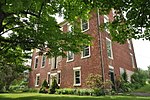White Creek Historic District
Federal architecture in New York (state)Greek Revival architecture in New York (state)Historic districts in Washington County, New YorkHistoric districts on the National Register of Historic Places in New York (state)Houses in Washington County, New York ... and 5 more
Houses on the National Register of Historic Places in New York (state)NRHP infobox with nocatNational Register of Historic Places in Washington County, New YorkUse mdy dates from August 2023Washington County, New York Registered Historic Place stubs

White Creek Historic District is a national historic district located at White Creek in Washington County, New York. It includes 20 contributing buildings. The buildings are predominantly residential and were built between 1770 and 1885. The majority are Greek Revival in style, with representatives of the Federal and Queen Anne styles. Greek Revival style commercial structures are also present and include a church, hotel / tavern, general store, and harness shop.It was listed on the National Register of Historic Places in 1979.
Excerpt from the Wikipedia article White Creek Historic District (License: CC BY-SA 3.0, Authors, Images).White Creek Historic District
Niles Road,
Geographical coordinates (GPS) Address Nearby Places Show on map
Geographical coordinates (GPS)
| Latitude | Longitude |
|---|---|
| N 42.971666666667 ° | E -73.289444444444 ° |
Address
Niles Road 4
12057
New York, United States
Open on Google Maps









